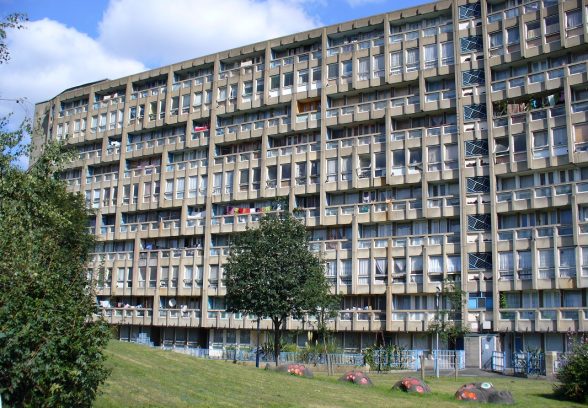This website uses cookies
This website uses cookies to enable it to function properly and to analyse how the website is used. Please click 'Close' to accept and continue using the website.



The future of the Robin Hood Gardens estate in Poplar, east London continues to hang in the balance. Tower Hamlets Council has applied to renew the five-year certificate of immunity from listing, which was granted in 2009 by the then Culture Secretary, Andy Burnham.
In response, the Twentieth Century Society is challenging the application, calling on English Heritage to reassess its decision not to list the 1972 apartment complex – a key work by Brutalist architects Alison and Peter Smithson.
C20 Society Director Catherine Croft said: ‘If it goes ahead, the demolition of Robin Hood Gardens will seem as inexplicable and misguided to future generations as the demolition of the Euston Arch does to us today. It’s a major work by architects of international stature. If it was not standing on such an incredibly valuable site, so close to Canary Wharf, refurbishment would be the obvious solution, preserving both the historically significant architecture, and an established community.’
The ‘streets in the sky estate’ was first threatened with demolition in 2008 as part of the Council’s plans to redevelop the area adjoining the Blackwall Tunnel.
At that time, C20 was part of a widely supported preservation campaign, backed by many leading architects. Richard Rogers, who compared the Smithsons’ pioneering social housing development to the ‘great crescents and squares’ of Bath, said demolition would be a tragedy.
In our new report to English Heritage, C20 Society argues, ‘We believe that none of the reasons given for not listing Robin Hood Gardens is convincing or properly evidenced according to listing criteria, and that the previous decisions not to list were unsound.’
We acknowledge that there are differing opinions about the merits of Robin Hood Gardens, but believe these may reflect ‘prejudice against social housing as a type, against modern architecture, or against the idea of the architect as intellectual’.
Referencing the estate’s distinctive concrete structure and open-air ‘street decks’, our report makes the case that EH fundamentally misunderstood the ‘aesthetic intention of the project’. We also believe that claims about the deteriorating fabric of the development (no maintenance has been done since 2000) have been overstated.
Our report also highlights the growing international reputation of Alison and Peter Smithson, whose school at Hunstanton, Norfolk is Grade II* listed.
‘No other British architects of the post-war era have the same international reputation as the Smithsons, save for James Stirling – who built widely abroad.’
English Heritage is currently reviewing the renewal application by Tower Hamlets Council and the C20 report calling for Robin Hood Gardens to be listed. English Heritage’s recommendation is expected to go to the Department of Culture, Media and Sport at the end of this month. The Secretary of State will then issue the final decision on listing.

Become a C20 member today and help save our modern design heritage.